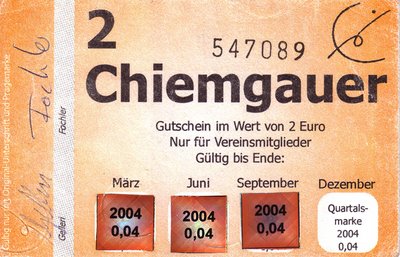A few days ago I got confronted with the following statement:
If a conventional currency turns enough times in a local economy, it has much the same effect as a complimentary currency.
I think that there is some truth to this statement - and at the same time it serves to illustrate why we need to use complementary currencies.
Local circulation is indeed the main purpose of complementary currency. This is best exemplified by a type of currency that is called 'Regio', mainly implemented in Germany. There, the local currency is a cash-based extension of the national currency. People by intention can only spend it locally, and participating businesses in turn can only use it to source goods and services locally. The consumer who intends to 'buy local' will find it is easy to do. It might be more challenging for participating businesses, as they consciously have to 'buy local', too. It might not matter much what coins and pieces of paper currency look like, but if they look differently, they are a constant reminder of our commitment to local economy and community. Something we can easily forget when we go shopping in our 'local' supermarket.
 (The Chiemgauer, the most famous of German Regio currencies!)
(The Chiemgauer, the most famous of German Regio currencies!)
As for other types of complementary currency, like LETS/Green Dollars/Timebanks, even more ties to the local community come into play. A cash-based currency is still a commodity, issued by an organisation. Green Dollars however are obligations and commitments between people in a community. They resemble a relationship, and the 'promises' behind those relationships are backed by the people who participate. A promise from one person to other people within a community is something very personal. This is entirely different from an anonymous piece of commodity that is handed from person to person, signifying some sort of 'value'.
 (HANDS: A New Zealand example of a LETS also using vouchers!)
(HANDS: A New Zealand example of a LETS also using vouchers!)
While it is absolutely correct that if national money circulating 10 times in the local community would do the job, we are not aware of how pervasive the leaks in our local economy really are. A complementary currency will help us to be aware, it will also help us remedy the situation.


2 comments:
The idea that local circulation is what's important about community currecies, is dead wrong. The key element is in fact local currency creation. If you can't create your currency locally, then that means that relative to your community, the currency is always extractive in nature because before you can trade, you first must export wealth. That is, you must buy the means of exchange with local wealth (time and resources), when in fact doing so is completely unnecessary.
Stated another way: the central problem with conventional currency, is that fundamentally it sets up an extractive pattern, where communities are beholden to the centralized currency creator for economic growth.
Local circulation is of course important, but far more important is the consciousness shift that happens when communities realize that they can create currency themselves. A community that can't issue its own currency is like a carpenter that runs out of inches with which to measure.
The question of local circulation was the one that was posed initially. It is an obvious feature of a complementary currency. However, the true impact and effectiveness of such a currency indeed does lie with the power to be able to create it locally.
I'm interested in the shift of consciousness you mention, Eric. How and when does it happen? Do we need to implement locally created currencies first to kick off this shift - or is it the shift that will eventually lead to currency created locally everywhere?
Post a Comment